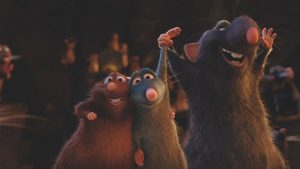
About the Film
The cute and fun film that was chosen for this project was Ratatouille. Ratatouille is a movie that was written and directed by Brad Bird who took over from Jan Pinkava in 2005. The film was released in the United States on October 12, 2007. It all starts in the setting of an old lady’s house somewhere just outside of Paris, France. But, the old woman is not the focus of the film, she is not the main character, the rats on top of her roof are. The main rats are Remy, Emile, and Django. All males, Django is the father of Emile and Remy, and Remy is the youngest brother. You see, rats are seen as dirty, vile, varmints, and pests. They are looked down upon and often killed once caught. So, as these rats sneak into the old woman’s house to get some food to bring back to their colony, they know they need to be very cautious. However, their attempts to safely sneak food do not go according to plan. In the beginning of the movie, Remy states “… I’m a rat, which means life is hard.” (00:02:10) Without any true spoilers, throughout the movie Remy has a dream of becoming a chef, not just any chef however, the greatest one. But, unfortunately, he is a rat, and as mentioned before, rats are seen as nasty little creatures and are obviously not expected to cook, that’s the last thing anyone would suspect of a little wild rat who lives underground, hidden from humans. But, Remy is determined to pursue his dream. His father Django does not trust humans in the slightest because of what they do to little things like them. He thinks Remy has lost his mind and does not want him to go to Paris to try and become a chef. Remy and Django bud heads because of this and Remy becomes infuriated that his father does not believe in him nor support him. His older brother Emile however, does believe in him. Emile has seen first hand what Remy can do, and although he is very worried for his younger brother, he supports him and helps him run away to the city of lights. Whilst in Paris, Remy meets a very kind human named Linguini. This human is alone, with no family, no friends, and no true career, only a mere garbage boy for the restaurant ‘Gusteau’s’. Once the two meet they become odd, but great friends and help each other out in the big city. Long-story short, Remy and Linguini find their passions, get the love and support they need, and live out their dreams. A ‘happily ever after’ type of ending.
Role
From some people’s point of view, the role that food plays in this film may seem overrated, or think that it is a great use of food all because people get the impression that this movie is all about food, and chefs’ struggles with keeping up and meeting their head chefs’ expectations. But this movie is more about a “little chef” (00:34:03) with a dream and the determination to become a great chef, and about a young man with nothing to lose who has the help and encouragement from this “little chef.” It is not really about food within itself, but more the journey and hardships that a rat has to get through in order to be great in the field of culinary arts. The food aspect of the film seems to play a underrated roles in my eyes, and that is because, besides the dish ‘Ratatouille’ they serve towards the end of the movie, the film does not seem to focus on the dishes themselves so much as this little rat named Remy becoming a chef and helping his human-friend Linguini get his life started in the culinary world.
Themes
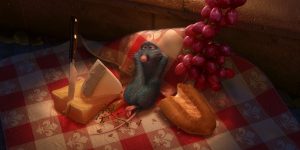
When discussing the themes found within the film, there is believed to be at least three. Those themes include taste, consumption, and cultural capital. If you know this film, taste would more than likely be the first thing that comes to mind, it seems to be the most obvious one. The films’ name is ‘Ratatouille,’ a French Provençal stewed vegetable dish. Some common ingredients include tomato, garlic, onion, courgetti, aubergine, capsicum, and some combination of leafy green herbs common to the region. The film has many parts where it shows the cooking and prepping of many dishes. Like when Remy and Linguini decide to practice their cooking abilities together in Linguini’s apartment where they make spaghetti (00:38:18). A scene in the movie that seems to really represent taste, on the objective and skill side of things, is the scene where Remy uses his heightened sense of taste and smell to combine the flavors of a piece of cheese and a strawberry. Both were good separate, but “combine the two together, and something new was created,” says Remy referring to the totally different flavors the two pieces of food create (00:04:26-52). The objective part is all about the tastes and the five shared types of tastes that we have, including sweet, sour, salty, bitter, and umami. For the skill aspect, that is known as the ‘arbiter of taste,’ the elegance of some flavors together, such as wine and cheese, or strawberries and cheese as Remy had, had.
The next theme is consumption, and particularly as a meal: the consumption of two or more foods in a structured setting at a set time. The film does not give exact times that the food is prepared or served, but it does give great examples for this set theme of the film. There is one scene in particular that always catches my attention. This is a scene that kind of helps tie into the role of food in the film as well and how it is about homage, and takes the person consuming the food ‘back to their roots.’ Throughout the movie, there is a threat to the restaurants of Paris, this ‘threat’ is named Anton, also known as “The Grim
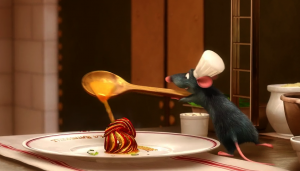
Eater” (00:01:05) and one of the largest food critics in all of Paris. This scene takes place towards the end of the movie and this is where Anton steps into Gusteau’s Restaurant and asks the chef to make anything they wish. Remy takes a chance and decides to make Ratatouille for the incredibly intimidating food critic. Colette, a chef at the restaurant and Linguini’s new girlfriend, thinks it is a “peasant dish” (01:35:12), but agrees to serve it to Anton regardless. Once it is made and given to Anton, the scene goes to him taking a bite out of the Ratatouille dish and having a flash-back to when he was child. The image shows Anton walking into his childhood home from a frustrating and hurtful fall off his bike. His mother is in the kitchen cooking; she looks at him, sits him down, and gives him a style of Ratatouille only his mother would make. It was a sign of comfort, homage, and love. It then cuts back to Anton in awe of the dish. He falls in love with it and finishes his plate, practically licking it clean (01:36:27-37:22).
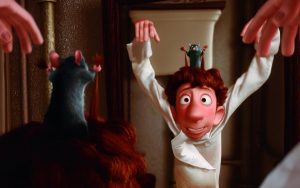
The final theme found in the film is cultural capital. This aspect of film comes from a side of ‘social norms’ and it is the shared amount of knowledge that one group knows and one does not know. Where there is some sort of value that is being brought into the experience. In the film, this can be found in the scene where Remy and Linguini discover that Remy can sit underneath Linguini’s chef hat and control what his arms and hands do by pulling on Linguini’s hair. Linguini is like a puppet on a string throughout the majority of the movie because of this odd thing they discovered. The two practice this puppetry in Linguini’s apartment whilst making spaghetti (00:37:20-39:35). See, Remy the rat is a great cook, which is odd. It is not normal for a rat to cook, but Linguini cannot cook in the slightest. So the two come together, come up with a solution to their problems, and work together to achieve their dreams and become “the dream-team” in this fancy restaurant.
Opinion
I truly love this movie. I love food, and seeing the things that were cooked and the aroma that said food was giving off made me want to jump through the screen and try it myself as a child, and even now. My only problem with this movie however, is that I feel as if the role that food plays here is underrated. As stated before, the film is more about a “little chef” (00:34:03) who wants to become a successful chef, and about a young man trying to get his life together and moving in a positive direction. It does not seem to be so much about the food as it is about the journey and hardships these two characters face. However, a strength it has happens to be one of my favorite quotes of the entire film, “Anyone Can Cook,” a best-selling book and quote by the owner and founder of Gusteau’s Restaurant, Gusteau himself (00:01:05). Even though this is an animated film, and most likely intended for a younger audience, that little quote makes me think that a terrible cook like me could become as great of a cook as my mother someday, with practice of course. It is quite empowering if you ask me, and overall, this movie is definitely one to consider watching some night when you are at home, on your couch with your family, eating popcorn, and having a great time.
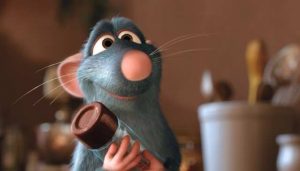
Resources
- Lewis, Brad. (Producer) & Bird, Brad. (Director). (2007) Ratatouille [Motion Picture] United States: Pixar Animation.